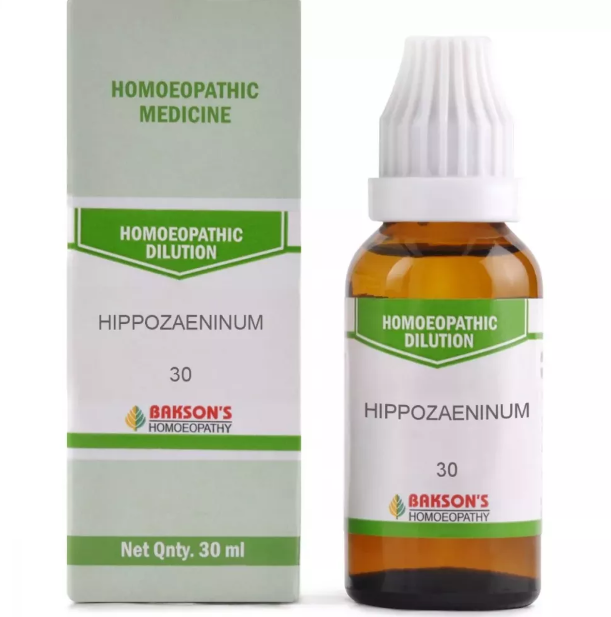HIPPOZAENINUM 6C, 12C, 30C, 200C, 1M, 10M USES AND SYMPTOMS
 HIPPOZAENINUM
HIPPOZAENINUM
(Gladerine Mallein, Farcine)
This potent nosode, introduced by Dr. J. J. Garth Wilkinson, addresses symptoms related to consumption, cancer, syphilis, etc., and is promising for treating ozena, scrofulous swellings, pyemia, erysipelas, and chronic rhinitis with saneous secretion.
Nose: Red, swollen, with catarrh, ozena, and ulceration. Discharge is acrid, corroding, bloody, and offensive. Tubercles on alae nasi, and papules and ulceration in the frontal sinus and pharynx.
Face: Swollen glands (parotitis), painful, forming abscesses.
Respiratory: Hoarseness, bronchial asthma, noisy and irregular breathing, cough with dyspepsia, excessive secretion, and imminent suffocation. Bronchitis in the elderly with a risk of suffocation from excessive secretion. Tuberculosis.
Skin: Lymphatic and articular non-fluctuating swellings, nodules in the arm, malignant erysipelas, pustules, abscesses, ulcers, and rupia. Eczema.
Relationship: Compare with Mucotoxinum (Cahis’ preparation with Micrococcus catarrhalis, Friedlander’s Bacillus of pneumonia, and Micrococcus tetragenius for acute and chronic mucus catarrhs in children and the elderly), Aur., Kali-bi., Psor., Bac.
Dose: Thirtieth potency.
SYMPTOMS OF HIPPOZAENINUM
Nose:
Red, swollen
Catarrh, ozena, ulceration
Discharge: acrid, corroding, bloody, offensive
Tubercles on alae nasi
Papules and ulceration in the frontal sinus and pharynx
Face:
Swollen glands (parotitis)
Painful glands
Abscess formation
Respiratory:
Hoarseness
Bronchial asthma
Noisy and irregular breathing
Cough with dyspepsia
Excessive secretion
Imminent suffocation
Bronchitis in the elderly with risk of suffocation from excessive secretion
Tuberculosis
Skin:
Lymphatic swellings
Articular non-fluctuating swellings
Nodules in the arm
Malignant erysipelas
Pustules, abscesses, ulcers, rupia
Eczema
selection of the potency
Individualization:
- Homeopathy is based on the principle of treating the individual, not just the disease. The unique symptoms and characteristics of the person are crucial in determining the most suitable potency.
Intensity of Symptoms:
- The intensity of the symptoms guides the choice of potency. If the symptoms are intense and acute, a lower potency (e.g., 6C, 30C) might be considered. For chronic conditions with less intensity, higher potencies (e.g., 200C, 1M) may be appropriate.
Sensitivity of the Patient:
- Some individuals are more sensitive to homeopathic remedies, while others may require higher potencies. The practitioner considers the patient’s sensitivity when selecting the potency.
Acute vs. Chronic Conditions:
- Lower potencies are often used for acute conditions, while higher potencies may be considered for chronic or long-standing issues.
Previous Response to Potencies:
- The patient’s response to previous homeopathic treatments helps guide the choice of potency. If a particular potency has been effective in the past, it may be repeated or adjusted as needed.
Vital Force and Susceptibility:
- Homeopathy views illness as a disturbance in the vital force. The practitioner assesses the patient’s overall vitality and susceptibility to determine the appropriate potency.
Aggravation or Amelioration:
- The direction of the symptom response (aggravation or amelioration) after taking a remedy can influence the choice of potency.
Miasmatic Considerations:
- In classical homeopathy, the concept of miasms (inherited disease tendencies) is considered. The practitioner take this into account when selecting the potency.
Practitioner Experience:
- The experience and preference of the homeopathic practitioner play a role. Some practitioners may have success with certain potencies based on their clinical experience.
SAFETY INFORMATION
- Do not exceed the recommended dose by physician
- Keep out of the reach of children
- Store in a cool dry place away from direct sunlight
- Maintain half an hour gap between food/drink/any other medicines and homoeopathic medicine
- Avoid any strong smell in the mouth while taking medicine e.g. camphor, garlic, onion, coffee, hing
Medicine images use for reference only selection of homeopathic medicine depends on the individual’s specific symptoms and overall constitution. Moreover, homeopathy is a holistic system of medicine that treats the individual as a whole. In addition to addressing the physical symptoms, it takes into account the emotional and mental state of the person. Consequently, it’s crucial to consult with a qualified homeopathic practitioner for personalized treatment.
The information provided on this website is intended solely for educational purposes. Always seek the advice of your physician or other qualified health provider.
